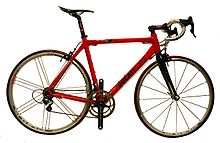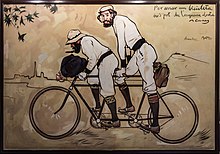Bicycle
![]()
This article is about the means of transport. For the 1982 DEFA German film drama, see The Bicycle.
A bicycle, short wheel, in Switzerland Velo (from French le vélo, short form for vélocipède 'fast foot'; Latin velox 'fast' and pes 'foot'), is an at least two-wheeled, usually single-track land vehicle, which is driven exclusively by the muscle power of persons on it by pedalling or hand cranks. Due to the caster, a steering deflection produces a torque which opposes it as a restoring torque. This causes the rolling vehicle to steer itself back to (almost) straight ahead. The gyroscopic forces also stabilize the bike as it moves, depending on the moment of inertia and the speed. In addition, other factors such as mass distribution have an influence on the driving stability of single-track vehicles (see also: Driving physics (bicycle)).
A unicycle has only one wheel, over which all tilting directions must be balanced. The tandem bike is a special form that allows two or more people to have their own seat and use their own muscle power. Special forms such as tricycles for children or senior citizens and three-wheeled recumbents have three wheels and are three-lane. Cycle rickshaws (such as cycle taxis) can be either three-wheeled or four-wheeled (two-lane). Another special type is experimental bicycles, which have a variety of running wheels or other muscle-powered forms of propulsion.
There are specific legal requirements for the use of a bicycle on public roads in each country (see Cycling).

A recumbent (here a short recumbent)

A racing bike from Ducati

Ramon Casas i Pere Romeu en un tàndem , painting by Ramon Casas i Carbó from 1897

28 inch men's touring bike, here: lugged diamond framewith double top tube
Name
The word bicycle was introduced by the German cyclists' associations in 1885 as the German equivalent of the English term bicycle (English from French: le vélocipède bicycle = "the two-wheeled velocipede"). The new term increasingly came to be used in everyday language alongside the established French term velocipede. It was finally able to assert itself when, during the Weimar Republic, French was visibly rejected as the language of the high nobility. The words Radfahrer (colloquially: cyclist) and Radfahren also originated from German cyclist associations. Until the mid-1920s, the term bicycle tended to be used for motorcycles, and their engine was often called a bicycle engine.
Regional terms are Fietse in Low German (similar to "Fiets" in Dutch) and Leeze in the special language Masematte in parts of the Münsterland. In some German dialects the bicycle is called a variation of Veloziped, such as Flitzepie in Solingen Platt or Flitzepääd in Sauerland. German-speaking Switzerland retained the abbreviation Velo as vélocipède until today. In Bavaria and Austria it is usually called "Radl" for short.
General joking terms for the bicycle are Drahtesel and Stahlross.
International days of action or commemoration
On the last Friday of every month, there are worldwide demonstrations for better cycling conditions in the form of Critical Mass bike rides ("Critical Mass"). Special forms are the World Naked Bike Ride, where people ride more or less undressed, and meanwhile the Kidical Mass ("Childish Mass"), where primarily children and teenagers ride along.
Every year on 3 June, the "World Cycling Day", proclaimed by the United Nations on 12 April 2018 as an official UN Day of Awareness of the Social Benefits of Cycling, and since 1998 also the "European Cycling Day" are celebrated.
On the 3rd Wednesday of May each year, the Ride of Silence is held internationally, where cyclists remember and commemorate their colleagues who have died in traffic accidents, in 2020 in almost 140 locations in seven countries worldwide (as of 18 May).
Bicycle Day, on the other hand, which takes place annually on April 19, is not a bicycle-related day of action, contrary to the name, but the anniversary of the discovery of LSD, since its discoverer Albert Hofmann had the first LSD intoxication on this day (April 19, 1943) and rode his bicycle in this state.

World Naked Bike Ride Zaragoza 2009
Questions and Answers
Q: What is a bicycle?
A: A bicycle is a small, human-powered land vehicle with a seat, two wheels, two pedals, and a metal chain connected to cogs on the pedals and rear wheel.
Q: Where does the name "bicycle" come from?
A: The name "bicycle" comes from the prefix "bi-" meaning two, and the suffix "-cycle" meaning wheel.
Q: How is a bicycle powered?
A: A bicycle is powered by a person riding on top, who pushes the pedals around with his or her feet.
Q: What is the most popular type of cycling?
A: The most popular type of cycling is Utility cycling.
Q: What are some other ways that cycling is used?
A: Cycling is also a common recreation, a good form of low-impact exercise, and a popular sport.
Q: What is the second most popular spectator sport in the world?
A: Road bicycle racing is the second most popular spectator sport in the world.
Q: How does bicycling compare to other forms of transportation in terms of energy usage?
A: Bicycling uses less energy per mile than any other human transport.
Search within the encyclopedia